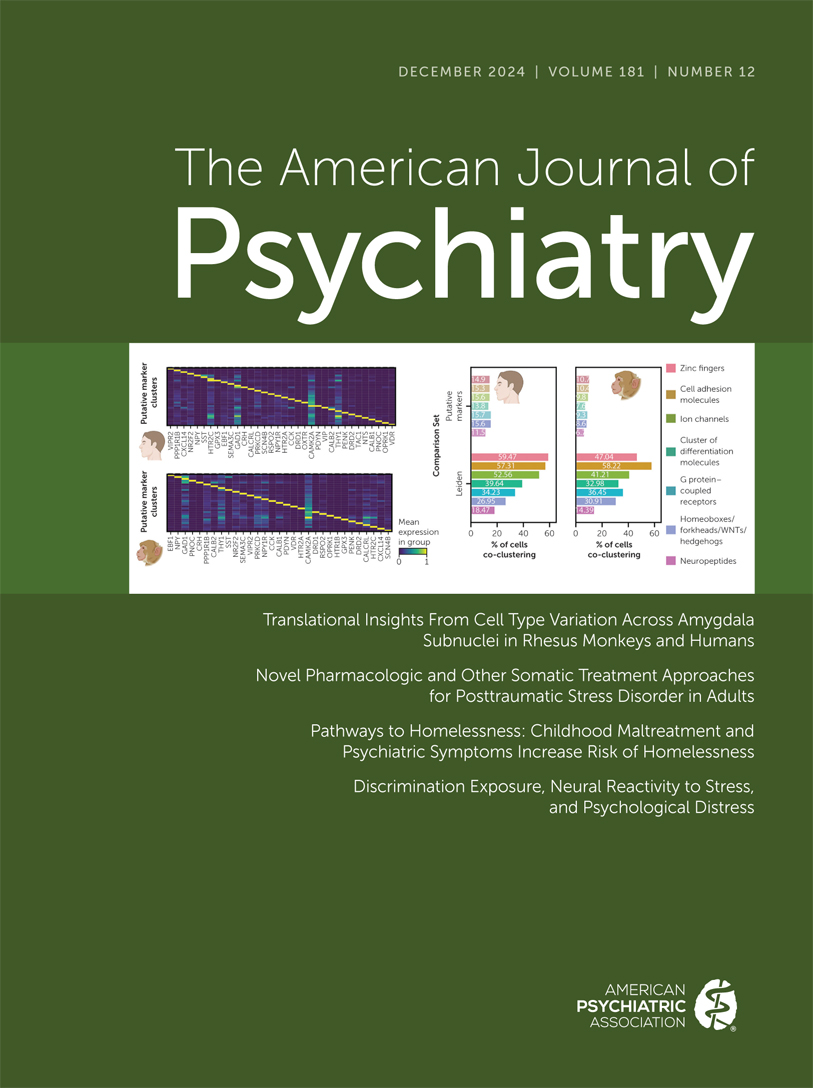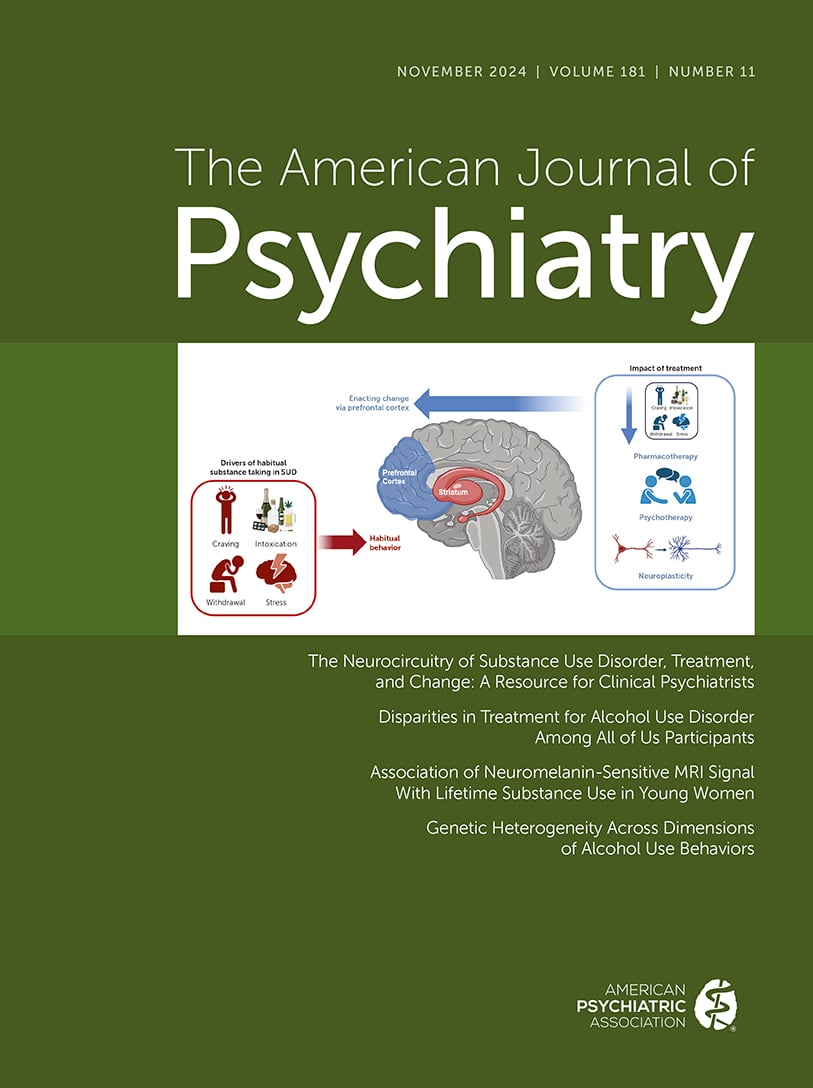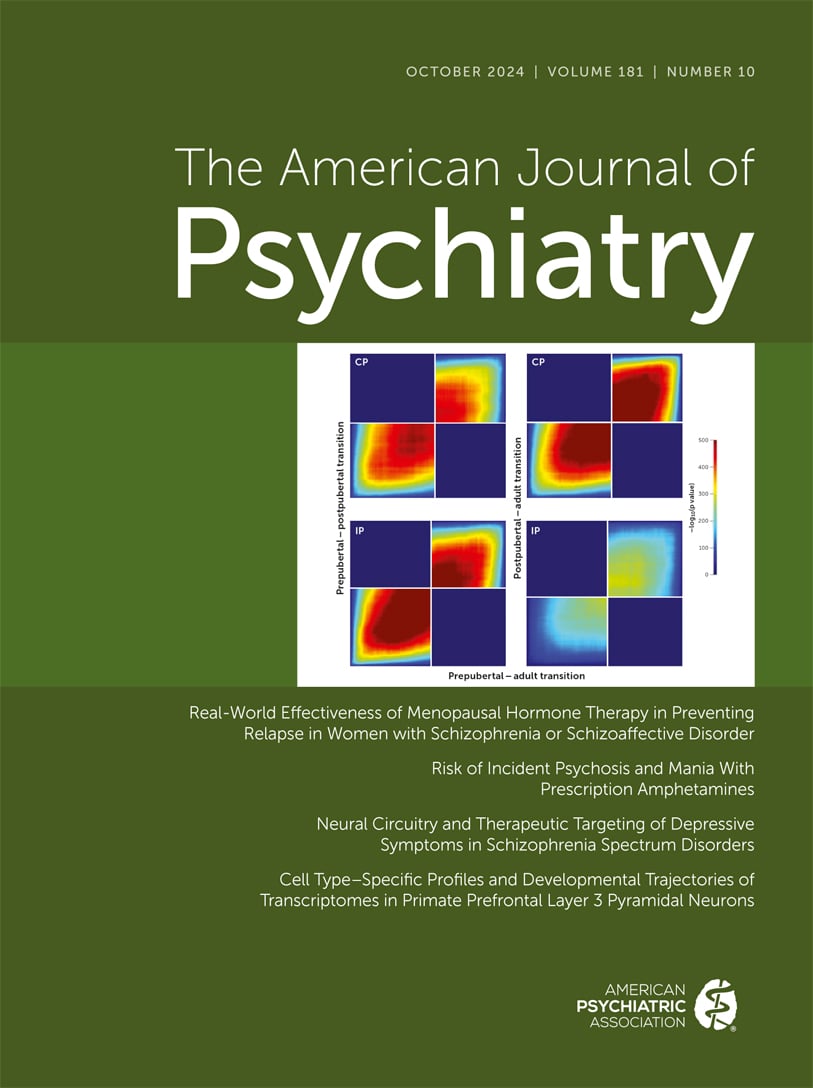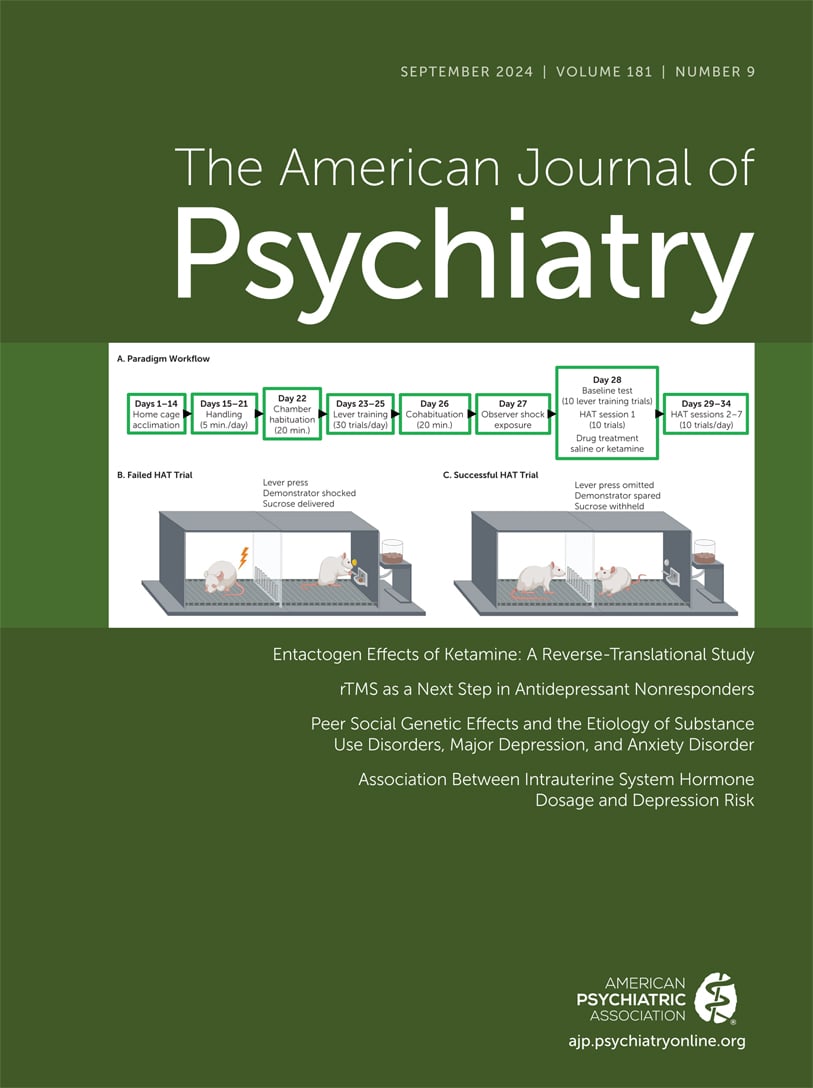American Journal of Psychiatry
- Volume 161
- Number 1
- January 2004
In This Issue
Editorial
Reviews and Overviews
Publication date: 01 January 2004
Pages3–18OBJECTIVE: The term “mood stabilizer” is widely used in the context of treating bipolar disorder, but the U.S. Food and Drug Administration (FDA) does not officially recognize the term, and no consensus definition is accepted among investigators. The ...
https://doi.org/10.1176/appi.ajp.161.1.3Publication date: 01 January 2004
Pages19–24Insomnia and depression are common problems with profound public health consequences. When left untreated, both conditions have high rates of persistence and recurrence. Maintenance treatment for depression is fairly well established, but there is no ...
https://doi.org/10.1176/appi.ajp.161.1.19Images in Neuroscience
Introspections
Clinical Case Conference
Images in Psychiatry
Article
Publication date: 01 January 2004
Pages36–44OBJECTIVE: This study used functional connectivity analyses to assess interregional brain activity correlations during the recall of traumatic memories in traumatized subjects with and without posttraumatic stress disorder (PTSD). METHOD: Both 4-T ...
https://doi.org/10.1176/appi.ajp.161.1.36Publication date: 01 January 2004
Pages45–52OBJECTIVE: Intensive care often means exposure to physical and psychological stress, with long-lasting emotional sequelae for most patients. Psychiatric morbidity and negative effects on health-related quality of life were assessed in long-term survivors ...
https://doi.org/10.1176/appi.ajp.161.1.45Publication date: 01 January 2004
Pages53–58OBJECTIVE: Social anxiety is a frequent but often unrecognized feature in schizophrenia and is associated with a severe level of disability. To precisely define the assessment, impact, clinical correlates, and consequences of social anxiety in ...
https://doi.org/10.1176/appi.ajp.161.1.53Publication date: 01 January 2004
Pages59–66OBJECTIVE: Social phobia is a common, sometimes disabling, fear of situations that might entail scrutiny by others. Several anxiety disorders, including social phobia, are genetically influenced. Genetic linkage analysis can provide the means to identify ...
https://doi.org/10.1176/appi.ajp.161.1.59Publication date: 01 January 2004
Pages67–71OBJECTIVE: This study investigated the neural substrates of implicit sequence learning in subjects with and without small animal phobia, in a follow-up to analogous studies of obsessive-compulsive disorder (OCD). METHOD: Ten subjects with specific phobia ...
https://doi.org/10.1176/appi.ajp.161.1.67Publication date: 01 January 2004
Pages72–78OBJECTIVE: Behavioral, electrophysiological, and imaging studies have found evidence that anxiety disorders are associated with left hemisphere dysfunction or higher than normal activation of right hemisphere regions. Few studies, however, have examined ...
https://doi.org/10.1176/appi.ajp.161.1.72Publication date: 01 January 2004
Pages79–87OBJECTIVE: Considerable evidence suggests a connection between panic disorder and respiration, but the nature of the respiratory abnormalities in panic disorder remains unclear. The authors investigated the breath-by-breath complexity of respiration ...
https://doi.org/10.1176/appi.ajp.161.1.79Publication date: 01 January 2004
Pages88–92OBJECTIVE: The authors sought to determine the association between panic attacks and psychoticism among young adults in the community. METHOD: Data were drawn from a 21-year longitudinal birth cohort study (N=1,265). Negative binomial regression models ...
https://doi.org/10.1176/appi.ajp.161.1.88Publication date: 01 January 2004
Pages93–98OBJECTIVE: Anecdotal reports have suggested mood improvement in patients with bipolar disorder immediately after they underwent an echo-planar magnetic resonance spectroscopic imaging (EP-MRSI) procedure that can be performed within clinical MR system ...
https://doi.org/10.1176/appi.ajp.161.1.93Publication date: 01 January 2004
Pages99–108OBJECTIVE: To examine structural abnormalities in subregions of the prefrontal cortex in elderly patients with depression, the authors explored differences in gray matter, white matter, and CSF volumes by applying a parcellation method based on magnetic ...
https://doi.org/10.1176/appi.ajp.161.1.99Publication date: 01 January 2004
Pages109–115OBJECTIVE: Neuroimaging findings have identified lower cortical gray matter volume in schizophrenia. Apoptosis (programmed cell death) has been proposed as a contributing pathophysiological mechanism. Levels of antiapoptotic Bcl-2 protein are low in the ...
https://doi.org/10.1176/appi.ajp.161.1.109Association of Anticholinergic Load With Impairment of Complex Attention and Memory in Schizophrenia
Publication date: 01 January 2004
Pages116–124OBJECTIVE: The authors’ goals were 1) to establish a clinically useful standard index of the relative anticholinergic potency of psychiatric medications; 2) to determine which cognitive functions are most affected by the administration of anticholinergic ...
https://doi.org/10.1176/appi.ajp.161.1.116Publication date: 01 January 2004
Pages125–132OBJECTIVE: The catechol O-methyltransferase (COMT) gene affects how long dopamine acts in the prefrontal cortex. The Methionine polymorphism, which results in a slower breakdown of prefrontal dopamine, is associated with better adult prefrontal cortex ...
https://doi.org/10.1176/appi.ajp.161.1.125Publication date: 01 January 2004
Pages133–138OBJECTIVE: Association between attention deficit hyperactivity disorder (ADHD) and the 7-repeat allele of a variant (a 48bp variable number of tandem repeats) in the dopamine D4 receptor gene (DRD4) has been widely documented. A meta-analysis of 21 ...
https://doi.org/10.1176/appi.ajp.161.1.133Publication date: 01 January 2004
Pages139–145OBJECTIVE: Individuals with co-occurring psychiatric and substance use disorders are treated in mental health and substance abuse treatment systems, yet research on comorbid disorders rarely includes comparisons across systems. Knowledge about patients ...
https://doi.org/10.1176/appi.ajp.161.1.139Publication date: 01 January 2004
Pages146–153OBJECTIVE: Many health care organizations are giving feedback to mental health care providers about their performance on quality indicators. Mental health care providers may be more likely to respond to this feedback if they believe the indicators are ...
https://doi.org/10.1176/appi.ajp.161.1.146Brief Report
Publication date: 01 January 2004
Pages154–156OBJECTIVE: Enlargement of the lateral ventricles is among the most frequently reported macroscopic brain structural changes in schizophrenia, although variable in extent and localization. The authors investigated whether ventricular enlargement is related ...
https://doi.org/10.1176/appi.ajp.161.1.154Publication date: 01 January 2004
Pages157–159OBJECTIVE: Apathy is a common negative symptom in schizophrenia. The authors investigated neuropsychological performance and regional brain volumes in schizophrenia patients with high versus low levels of apathy. METHOD: Schizophrenia patients with low ...
https://doi.org/10.1176/appi.ajp.161.1.157Publication date: 01 January 2004
Pages160–163OBJECTIVE: Since most of the world’s schizophrenia patients are treated with conventional antipsychotics, the authors evaluated various methods for establishing the prevalence of neuroleptic-induced movement disorders in these patients. METHOD: DSM-IV ...
https://doi.org/10.1176/appi.ajp.161.1.160Publication date: 01 January 2004
Pages163–165OBJECTIVE: Antidepressant responses were compared in DSM-IV bipolar and unipolar depression. METHOD: The authors analyzed clinical records for outcomes of antidepressant trials for 41 patients with bipolar depression and 37 with unipolar depression, ...
https://doi.org/10.1176/appi.ajp.161.1.163Publication date: 01 January 2004
Pages166–168OBJECTIVE: The present study aimed to 1) assess facial expression recognition in subjects with a previous history of major depressive disorder relative to subjects with no history of depression and 2) characterize the effects of acute citalopram infusion ...
https://doi.org/10.1176/appi.ajp.161.1.166Publication date: 01 January 2004
Pages169–171OBJECTIVE: The goal of this study was to determine the benefits of the continued use of a typical antipsychotic agent following remission from an acute manic episode. METHOD: Immediately following remission of a manic episode treated with the combination ...
https://doi.org/10.1176/appi.ajp.161.1.169Publication date: 01 January 2004
Pages171–174OBJECTIVE: This study was conducted to determine the efficacy and safety of riluzole, a glutamate-modulating agent, in patients with recurrent major depression. METHOD: After a 1-week drug-free period, subjects 18 years or older with a diagnosis of ...
https://doi.org/10.1176/appi.ajp.161.1.171Letter to the Editor
Book Forum: Psychiatry in Society
Book Forum: Children and Adolescents
Book Forum: Treatment Issues
Book Forum: Forensic Psychiatry
Correction
Past Issues
View Issues Archive
Vol. 181 | No. 12

Vol. 181 | No. 11

Vol. 181 | No. 10
